The Microsoft Surface Pro 6 Review: More Than A Color
by Brett Howse on October 16, 2018 3:01 AM EST- Posted in
- Laptops
- Microsoft
- Surface
- Tablets
- Surface Pro
- Surface Pro 6
System Performance
As of late, Microsoft’s launch schedule for Surface doesn’t seem to coincide with the industry norms, and that continues with the Surface Pro 6. Surface Pro 4 and Surface Book were the launch devices for Intel’s latest Skylake processors, and power management issues with that series of SoC has likely made the Surface team a bit wary about being first out of the gate again. As such, the release cadence doesn’t fall in-line with the normal yearly update as with most OEMs.
So, it’s a bit delayed, but with the Surface Pro 6 we get our first Microsoft designed convertible tablet with the quad-core lineup of 8th generation Intel Core CPUs, which have generally made a pretty sizeable impact in terms of overall device performance compared to the outgoing Kaby Lake dual-core U series. Microsoft is offering the Surface Pro 6 with either the Core i5-8250U, or the Core i7-8650U, both of which are Kaby Lake Refresh. Intel has just recently launched their latest Whiskey Lake processors though, so once again we see Microsoft updating at the tail end of a generation. The good news this time is that there aren’t significant changes for Whiskey Lake, although the inclusion of hardware mitigations to the Spectre and Meltdown vulnerabilities would have been welcomed.
The maximum RAM is still the same 16 GB as seen for a while, and this limitation is due to the maximum RAM size of LPDDR3, which we still see in most low-power PCs. Intel hasn’t added LPDDR4 support to any of their lineup yet with the exception of their Gemini Lake Atom based CPUs.
Last year we were able to check out the Core i7-7660U model of Surface Pro, which offered Intel Iris graphics and 64 MB of eDRAM cache, but the Iris model is no longer available in the 15-Watt range, so for this year, at least for now, Microsoft has had to step back to the traditional UHD 620 graphics.
Starting with the 2017 Surface Pro, Microsoft removed the fan from the Core i5 model, and that has continued with the 2018 Surface Pro 6, so this is our first chance to check out a fanless Surface Pro as well.
To test system performance the Surface Pro 6 was run through our standard suite of laptop tests. If you’d like to compare its performance against any other device we have tested, please check out our Laptop Bench.
PCMark
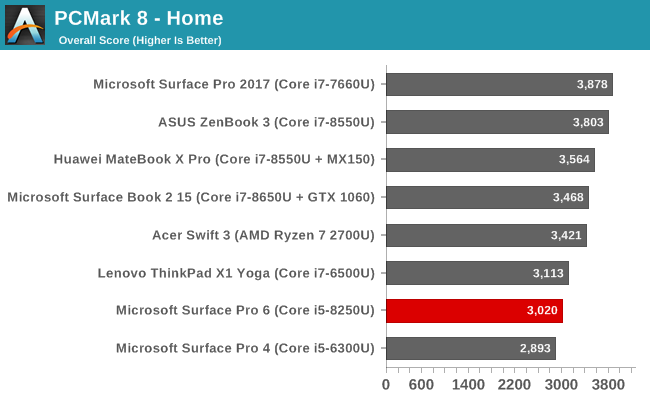
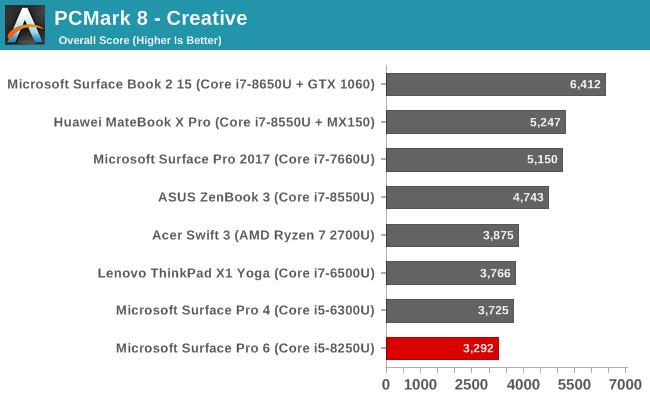
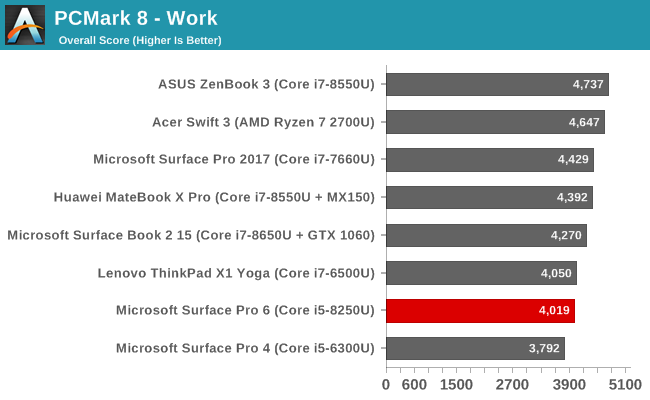
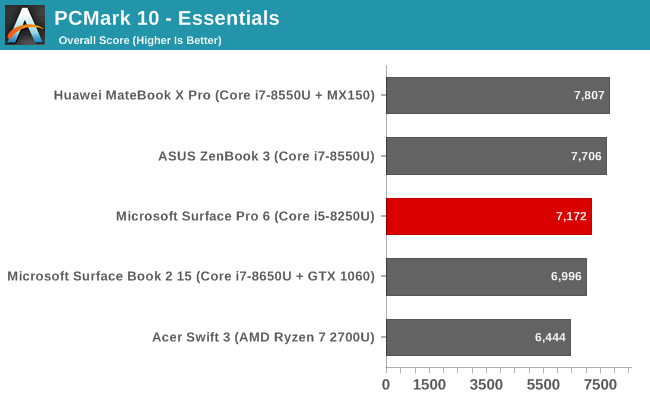
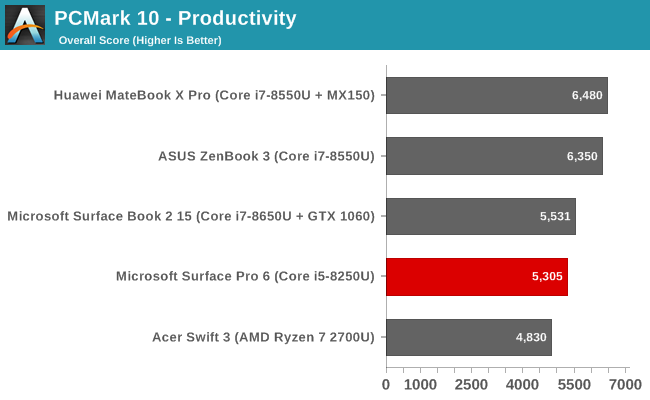
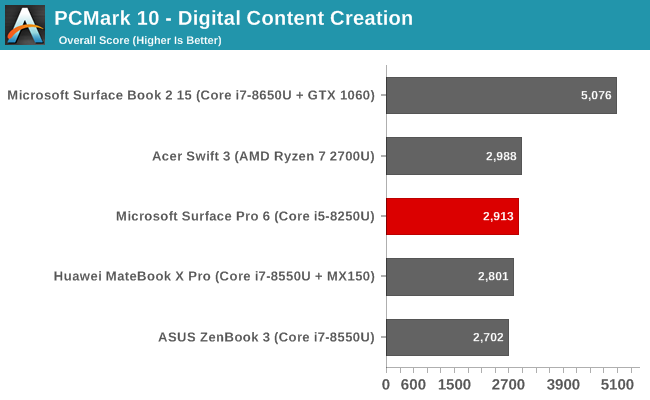
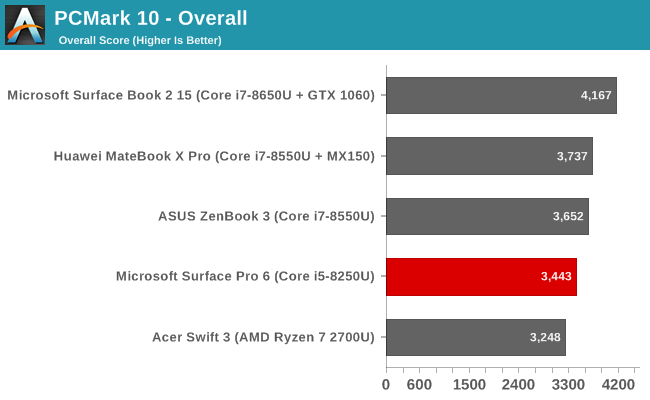
UL Benchmarks PCMark is a good tool to evaluate overall system performance, since it tests all aspects of the device. The Core i5 model can’t quite hang with the fastest Core i7 laptops around, but considering it’s the only laptop in the lineup that is passively cooled, it does remarkably well.
Cinebench
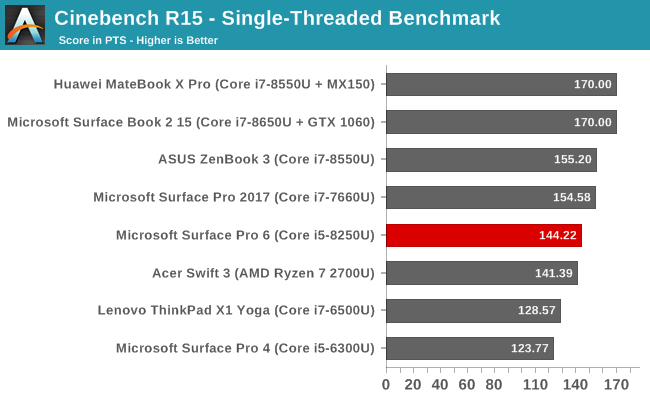
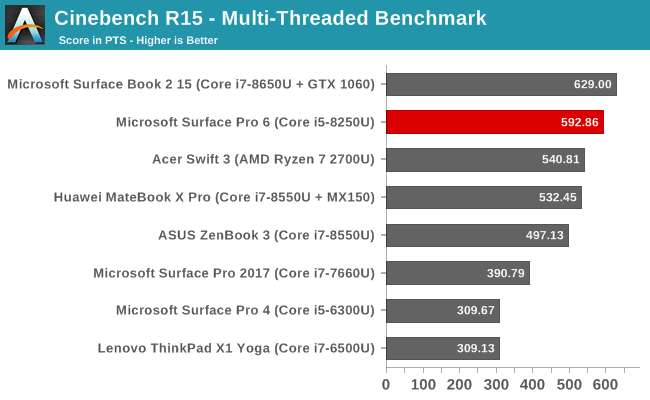
Cinebench R15 is purely CPU based test, and can be run in either single-threaded mode, or multi-threaded where more cores and higher turbo frequencies can really improve overall scores. In the single-threaded tests, the Core i5 in Surface Pro 6 is right in the middle of the pack, with it’s maximum boost frequency of just 3.4 GHz compared to a maximum boost of 4.2 GHz in a Core i7-8650U. But when you scale up the workload to multiple cores, the two extra cores and four extra threads in the Kaby Lake Refresh processor catapult it near the top, offering 66% more performance than the Core i7-7660U in last year’s Surface Pro.
x264
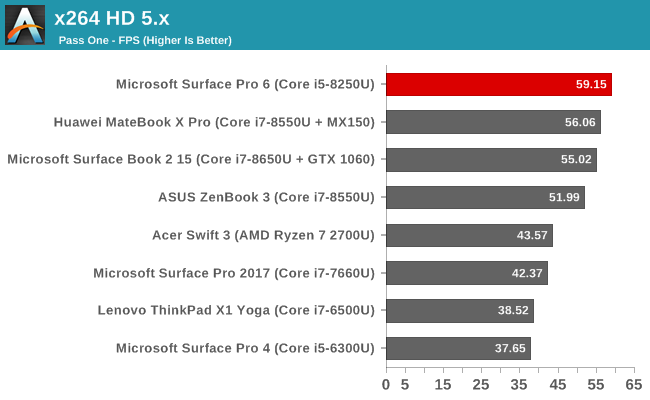
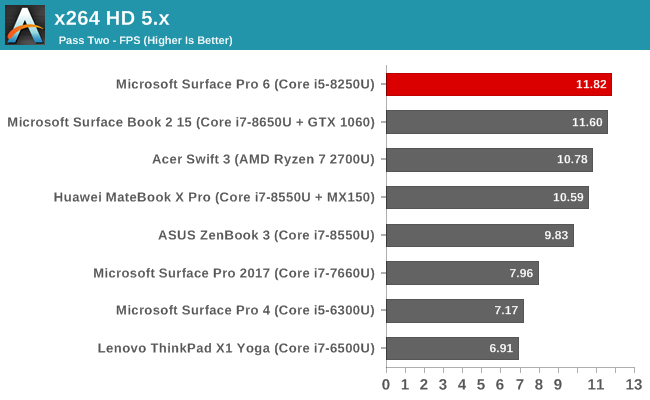
Another CPU test, x264 converts a video using the CPU, and generally scales well across more cores and threads, so the quad-core Surface Pro 6 does very well here, actually outperforming even the Core i7 in other devices. This is also quite a long test, meaning the Surface Pro 6 certainly would have run into its thermal limit, but it still offered excellent performance, meaning the passive cooling system was able to cope.
Web Tests
All of our web tests are run using the latest version of Microsoft Edge, and the Surface Pro 6 was tested on Windows 10 version 1803.
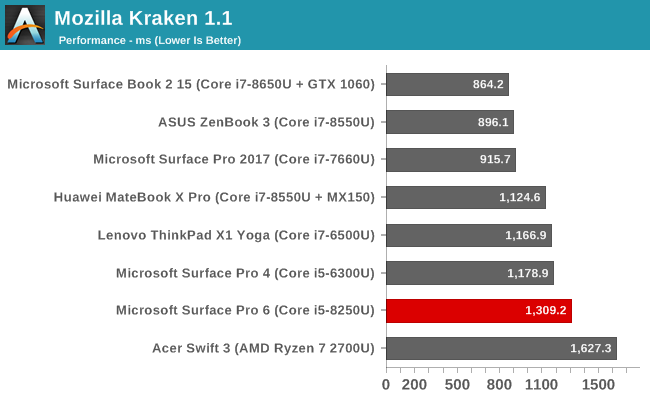
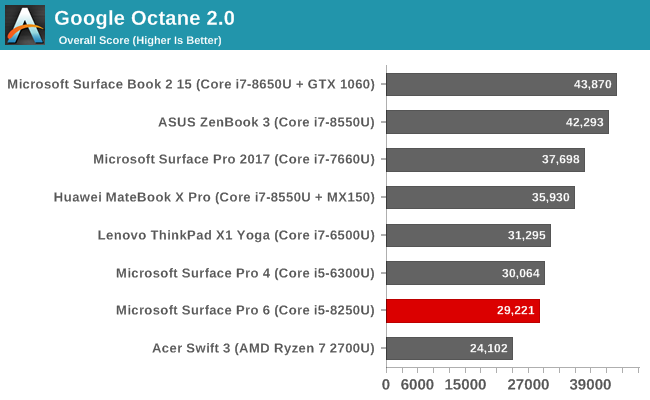
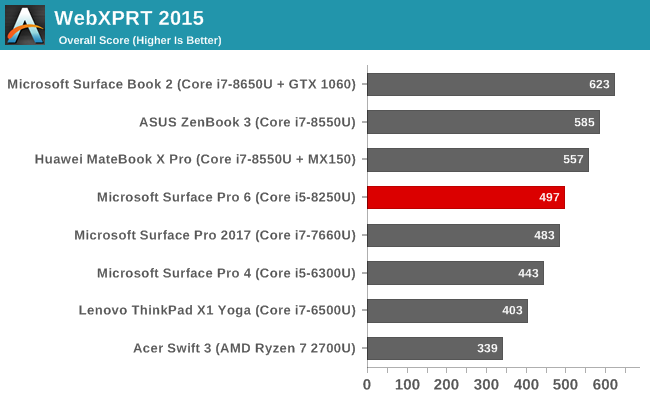
Here the Surface Pro 6’s Core i5 didn’t fare so well, with middling scores compared to the latest laptops around. Possibly due to the fanless nature, the PL2 values for the Surface Pro 6 were limited to around 23-Watts, and on other Kaby Lake Refresh devices, it’s not unusual to see 30-Watts for short bursts, and web tests tend to thrive on short bursts of performance.










80 Comments
View All Comments
sorten - Tuesday, October 16, 2018 - link
And to think that the only reason I have a SP4 instead of a SP3 is that I was holding out for a USB-C port! It would have been fairly early to market at that point. Looks like I made a great decision.damianrobertjones - Tuesday, October 16, 2018 - link
Tell me... what would you use that port for? You can do it... you can hold out for the Surface pro 3.You could always try the 'Surface Connect to USB-C Adapter'?
Heck wouldn't it be great to run USB c raid arrays with this? No.
Heck wouldn't it be great to have an external GPU with this? No, how much money do you have!?
Heck wouldn't it be great to have a fast usb C thumb drive? No, USB 3.1 drives are still selling lots.
Heck wouldn't it be great to have HDR?
Oh, here we go, the next excuse.
drew805 - Tuesday, October 16, 2018 - link
The main draw of the Type C is that I can charge my laptop and phone with the same charger (and even power my 2in1 with a mobile power pack with USB-PD). I fail to see how a more future proof port that already offers display out capacities is worse than the mini-DP in the SP5. Also, while External GPU's via Thunderbolt 3 are expensive, it is cheaper than building a complete desktop just to get a similar (or likely better) experience. Why is more choice bad?damianrobertjones - Wednesday, October 17, 2018 - link
It's not bad, at all, but the quality on the USB C chargers is startling. Same with the docks. Plus it's another change to overcharge for something that should realistically be cheap. While all of the printers, scanners, mice, keyboards and thumb drives are still USB, USB C can just wait.Plus there's always the MS adapter. People are probably not aware of that.
desolation0 - Wednesday, October 17, 2018 - link
Usb-c and usb-a ports aren't exactly mutually exclusive. We can pretty easily have both simple backwards compatibility and future proofing in the same model. Meanwhile the future proofing option offers obvious and significant utility opportunities that are just not available on the previous generation spec. To skip it on a flagship device when the tech has been available for years and is now being used by pretty much all of the competition even down to mainstream pricing levels seems like a significant oversight.digiguy - Tuesday, October 16, 2018 - link
Brett, I think you are underestimating the difference between the 2017 i5 and i7 in battery life. I have seen reports of over one hour more battery like in the fanless i5. So I don't think battery like in the 2018 model has improved much or at all. Once we have some direct i5 to i5 comparisons (eg. from notebookcheck) we'll be able to see if there is any improvement worth mentioning.OCedHrt - Tuesday, October 16, 2018 - link
The black levels on surface 6 and 4 are the same?Brett Howse - Wednesday, October 17, 2018 - link
Yes and the display is 100 nits brighter so being able to reproduce the same black level with a white that's 100 nits brighter is a sizeable improvement.evilspoons - Tuesday, October 16, 2018 - link
Argggh, I hate that Avastar wireless card so much. I have a Surface Pro 3 and it posts decent 802.11ac speeds for when the SP3 was new... most of the time... but sometimes it just decides to screw up and slow down by like 90%. Copying files over the network, wired gigabit to wired gigabit PC? 60 MB/sec, forever. 802.11ac adapter in my dad's laptop? 40 MB/s. That damn Avastar? 30 MB/s, until it decides to screw up, then 2.5! Yay!Holliday75 - Wednesday, October 17, 2018 - link
Yeah my SP3 is slower than shit on my WiFi. Usually get around 22-25MB/s. I had to force it to 5.2ghz to get those speeds.